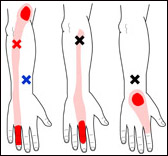This is a series on arm and hand pain causes. If you missed the beginning, go back to the Checklist. Treating arm and hand pain is an important part of my Neuromuscular Therapy practice near Boston.
 The extensor muscles are located on the back of the forearm (dorsum, like the dorsal fin of a fish) and attach to the bone at the outer side of the elbow called the lateral epicondyle of the humerus, (the upper arm bone). The extensors are arranged like a sandwich with the muscles that move the wrist on the outside, like the bread, closest to the two bones (radius and ulna) and those that move the fingers down the middle like the sandwich filling.
The extensor muscles are located on the back of the forearm (dorsum, like the dorsal fin of a fish) and attach to the bone at the outer side of the elbow called the lateral epicondyle of the humerus, (the upper arm bone). The extensors are arranged like a sandwich with the muscles that move the wrist on the outside, like the bread, closest to the two bones (radius and ulna) and those that move the fingers down the middle like the sandwich filling.
The extensors function to raise the fingers up as when preparing to strike a key on the piano or keyboard or before clicking a mouse. They help lift the wrist. They are also used in a power grip, like opening a jar or shaking hands.
Local pain from these muscles can be generated by dysfunction or injury to the muscles themselves, systemic factors like lack of blood or oxygen, or toxic pain from accumulated chemicals and waste.
Dysfunction would be from spasm, weakness, old traumas, and hyperactivity, but mostly from Trigger Points. Referred pain from these hypersensitive nodules goes down the forearm away from where it originates into the dorsum of the hand and often to the fingers. Patients will often rub the back of their hand when describing their symptoms. Pain can feel like arthritis in the fingers or tennis elbow. Other symptoms are a weak grip, difficulty bending the tip joint of the finger and stiffness or loss of range of motion.
 Trigger Points in the finger extensors are tricky to distinguish, but can be isolated by identifying a painful point in the forearm, then wiggling the fingers to feel which band of the muscle group is contracting at that tender point. Each band controls a specific finger and it’s TrP refers to that finger. The Trigger Point in the middle finger extensor is one of the most commonly found in the body. Pain from the ring finger and pinkie can project near to the outside of the elbow (lateral epicondyle), and pain from the short secondary pointer finger muscle is usually found where the wrist and the back of the hand meet.
Trigger Points in the finger extensors are tricky to distinguish, but can be isolated by identifying a painful point in the forearm, then wiggling the fingers to feel which band of the muscle group is contracting at that tender point. Each band controls a specific finger and it’s TrP refers to that finger. The Trigger Point in the middle finger extensor is one of the most commonly found in the body. Pain from the ring finger and pinkie can project near to the outside of the elbow (lateral epicondyle), and pain from the short secondary pointer finger muscle is usually found where the wrist and the back of the hand meet.
In making decisions about the causes of a patient’s arm and hand pain, local dysfunction should be differentiated from Trigger Point symptoms, but both are usually present simultaneously.